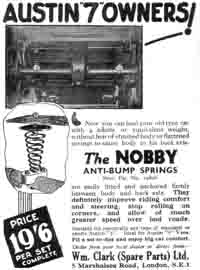
Austin Seven "Nobby" spring assistor kits - by Tony Eldridge
TECHNICAL TALK
"LOW IN THE STERN"
Written by Tony Eldridge
From the December 2001 edition of the The Austin Seven Owners Club (London) magazine
It is not uncommon to see Austin Sevens that are somewhat low in the stern especially if they are four seaters (not Chummies). No doubt there was a time when the Chummy models also had a settled rear end, but nowadays these versions always seem to be riding as Austin intended.
Now, as some of us may already know, the Austin Seven (Rubies excepted), does have two problems with its rear end. One is its design and the other is its Owner. The early cars have a chassis that effectively finishes where the rear springs are fitted, and the rear of the body is unsupported. This was presumably because the car was designed to be a two seater (for small 1920s people) with space at the rear for two small children or a few bits of luggage. However, people being what they are, they proceeded to cram adults in the rear and/or massive amounts of luggage. Before the 1920s were gone, problems had arisen with the bodywork cracking (a problem that continued to appear in future decades). Sometimes it was only the erected hood that stopped the rear half of a body departing from the front! Indeed, someone once told me that a friend of his bought an old Chummy with the hood up and on arriving home decided to lower the hood. He then found that the rear of body tilted backwards, it not being joined to the front!
Later cars were fitted with short chassis extension brackets in order to support the bodywork but these did not extend beneath the whole of the rear end even though they were better than nothing; and the cars continued to be overloaded especially bearing in mind they were used daily for longer than their maker would have envisaged. Saloon models in particular have been found to have suffered rear end distortion over the years which shows up in door openings that are not "square". Even if the A posts are sound and the doors hung properly, distorted openings mean that the doors don't fit the hole without gaps. If a body is being totally restored, the distortion can be rectified by brutal methods of jacking it so that the door apertures come right once more. The Austin Seven Companion goes into this subject. However, the problem of sagging back ends was solved by the low frames being properly constructed to carry a four seater body so that the frame gives complete support.
(Click on the above image for an enlargement of the original Advertisement)
As with all motoring problems not addressed by the car manufacturer, there is always some enterprising soul who offers an answer. In the case of sagging Austin Sevens, it was W M Clark (Spare Parts) Ltd of Marshalsea Road, London, S.E. 1. This was the firm that offered "Nobby" Spring Assisters that were fitted to the underside of the rear body and the rear axle. These springs were conical coil springs and were also said to stiffen up the back end of the car and improve the handling. The only problem with the assisters was that with floor pans weakened by rust, even with the reinforcing plates supplied, the springs eventually could punch their way through the floor of the tool boxes under the rear seats. There are still some cars fitted with the original "Nobby" springs, and soon there will be a whole lot more, including my PD Two Seater.
This revealing news is because William McKenzie who supports Austin Seven Owners with repro spare parts is now offering repro "Nobby" spring assistor kits (price £38 +p&p) thus providing even more support. My car had a set of the originals fitted when I got it in 1963, but I took them off and threw them away because I thought that they were a product of W E Bodgit & Co and superfluous tat. (In my defence for this, I might add that in 1963 lots of Austin Sevens were adorned with tat and grot not supplied by Herbert Austin!) So I have now purchased replacements in the hope that they will help to control the rear wheel steering which comes without extra charge on Austin Sevens as well as delaying the time when I will have to replace the original road springs. I have yet to fit them but I can tell you that they are very well made to the exact specification of W M Clark's product. A very substantial reinforcement plate comes with each spring as well as all the necessary nuts, bolts and washers, but it would seem prudent to make sure that the floor of the car is not lacking in substance. If so, some additional strengthening would be essential sooner rather than later.
I am looking forward to experiencing the improvements that the original manufacturers of this accessory were claiming when it was first offered in the late 1920s. In any event, period extras always seem to add charm to the cars especially if they prevent sagging bottoms.
[With thanks to Tony Eldridge who points out that the price above converted to present rates equals £39.04p for 1927 and £53.24p for 1934!]